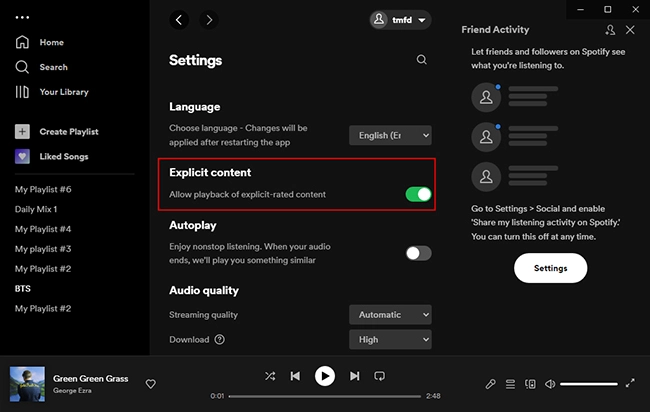Spotify has millions of songs, but some come with a small “E” next to their titles. So, what does this symbol mean? The “E” stands for “Explicit.” It’s a marker for tracks or albums with explicit content, such as strong language, references to violence, or adult themes. This label helps users decide if they want to listen or skip.
What Does the E Mean in Spotify and for Its Users?
When you see the “E” on Spotify, it’s a warning. The song might have explicit lyrics or themes that aren’t suitable for all audiences. This is especially useful when listening with kids or in public. Spotify gives you control over what you hear, so you can avoid content you find inappropriate.
How to Manage Explicit Content Settings in Spotify?
Spotify offers a variety of settings that allow you to control explicit content. Whether you want to block explicit tracks altogether or manage them on a device-by-device basis, Spotify’s tools make it easy to customize your listening experience.
1. Filter Explicit Content on Specific Devices
Spotify allows you to filter explicit content on individual devices. This means you can set different preferences for your smartphone, tablet, or computer. For example, you might want to allow explicit content on your personal phone but block it on a family-shared tablet.
To filter content on a specific device:

- Open the Spotify app on the device you want to manage.
- Tap on Settings (the gear icon) in the top-right corner.
- Scroll down to the Explicit Content section.
- Toggle the Allow Explicit Content option to turn it on or off.
By setting this up on each device, you can ensure that explicit content is blocked where you need it to be, such as in your child’s profile or a shared family device.
2. Block Explicit Content Entirely
If you prefer to avoid explicit content across all devices and users on your Spotify account, you can block it entirely. This will remove any songs, albums, or podcasts marked with the “E” from your search results, playlists, and recommendations.
Here’s how to block explicit content across your account:
- Open Spotify on your main device.
- Go to Settings.
- Find the Explicit Content section.
- Toggle the Allow Explicit Content option to the off position.
Once this is set, Spotify will automatically skip tracks with explicit content in playlists, even if you’re listening on a device where you haven’t manually adjusted the settings.
Want to see spotify wrapped, here is how.
3. Create a Separate Spotify Kids Account
If you have young children, Spotify Kids is a great option. This separate app is designed for children and only includes age-appropriate content. You won’t find any explicit tracks here, so you can let your kids explore music without worrying about what they might stumble upon.
- Setting up Spotify Kids:
- Subscribe to Spotify Premium Family, which includes Spotify Kids.
- Download the Spotify Kids app from the App Store or Google Play.
- Set up a profile for your child, including their age range to ensure they get appropriate content.
- Hand over the device, and let them explore a world of kid-friendly music!
With Spotify Kids, you don’t need to manually filter content, as the app itself is curated to exclude any explicit material.
4. Set Up a Family Plan with Content Control
Spotify’s Family Plan is another way to manage explicit content across multiple users. When you subscribe to the Family Plan, you can create individual accounts for each family member. As the account manager, you can control explicit content settings for each user, ensuring that younger members have restricted access.
- Managing content on a Family Plan:
- Sign up for Spotify Premium Family.
- Invite family members to join your plan through the Family Hub.
- For each member, go to their profile settings and adjust the Explicit Content toggle.
- Monitor and adjust these settings as needed.
This is particularly useful if you have teenagers who might want to listen to different content than younger children, allowing for personalized control.
5. Enable Spotify’s Clean Versions When Available
Another feature to consider is Spotify’s availability of clean versions of songs. Many tracks with explicit content also have a clean version, which is edited to remove inappropriate language or themes. While Spotify doesn’t automatically switch to clean versions, you can manually search for and add them to your playlists.
- Finding clean versions:
- Search for the song title followed by the word “Clean.”
- Look for the “Clean” label in the track’s title or description.
- Add this version to your playlist or library.
This option is ideal for those who enjoy certain songs but prefer a version without explicit content, allowing you to keep the vibe without the language.
Frequently Asked Questions – Spotify E Symbol Meaning
Why Does Spotify Use the “E” Symbol?
The “E” symbol is a guide for users. It tells you when a song might have content that’s not suitable for everyone.
What Types of Content Are Considered Explicit?
Explicit content includes strong language, references to drugs or violence, and adult themes. If it’s not appropriate for all ages, it gets the “E” label.
Is All Music with an “E” Explicit?
Not every song with an “E” is full of explicit content. Sometimes, it’s just a word or two. The “E” is there to help you decide if you want to listen or skip.
Can I Filter Out Explicit Content on Spotify?
Yes! Spotify makes it easy to avoid explicit content. You can adjust your settings to filter it out, giving you control over your listening experience.
Here’s What You Can Do:
To manage explicit content on Spotify:
- Open Spotify.
- Go to Settings (tap the gear icon).
- Find Explicit Content and toggle the setting on or off.
- Confirm Your Choice.
But How Can You Exactly Filter Out Content?
Spotify’s filtering is easy. Once you’ve adjusted the setting, songs with the “E” will be skipped, keeping your playlists clean.
Wrapping Up
The “E” on Spotify is there to help you manage your listening experience. Whether you want to avoid explicit content or don’t mind it, Spotify gives you the tools to choose. Understanding what the “E” means allows you to listen on your terms, whether at home, at work, or on the go.
